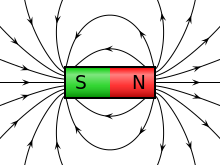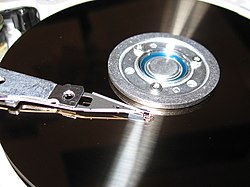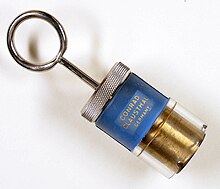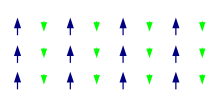|
|
#1 |
|
Join Date: Apr 2007
Location: Ohio
Age: 35
Posts: 204
|
how do magnets work?
|
|
|

|
|
|
#2 |
|
I don't get no respect
Join Date: Jun 2006
Age: 32
Posts: 1,332
|
electrons
|
|
|

|
|
|
#3 |
|
Pop'n Music.
|
 Last edited by Kagome; 12-11-2010 at 12:17 AM.. |
|
|

|
|
|
#4 |
|
FFR Player
|
Domains of electrons all "point" a certain way, thus creating a pull. That's the simple explanation.
|
|
|

|
|
|
#5 |
|
FFR Simfile Author
|
I'd look up the wikipedia article for it
__________________
Patashu makes Chiptunes in Famitracker: http://soundcloud.com/patashu/8bit-progressive-metal-fading-world http://img.photobucket.com/albums/v216/Mechadragon/smallpackbanner.png Best non-AAAs: ERx8 v2 (14-1-0-4), Hajnal (3-0-0-0), RunnyMorning (8-0-0-4), Xeno-Flow (1-0-0-3), Blue Rose (35-2-0-20), Ketsarku (14-0-0-0), Silence (1-0-0-0), Lolo (14-1-0-1) http://i231.photobucket.com/albums/ee301/xiaoven/solorulzsig.png |
|
|

|
|
|
#6 | ||
|
FFR Player
|
****in miracles
__________________
 Quote:
|
||
|
|

|
|
|
#7 |
|
FFR Player
Join Date: Jan 2009
Posts: 80
|
I'm goin with Dimitri and Kagome on this one.
|
|
|

|
|
|
#8 | |
|
Spun a twirly fruitcake,
Join Date: Feb 2009
Age: 31
Posts: 3,865
|

__________________
Quote:
|
|
|
|

|
|
|
#9 |
|
FFR Player
Join Date: Jul 2008
Location: wormland
Posts: 644
|
 Last edited by Gravity Kitten; 12-11-2010 at 07:34 AM.. |
|
|

|
|
|
#10 |
|
Forum User
Join Date: Jun 2009
Location: Houston
Age: 19
Posts: 2,964
|
 |
|
|

|
|
|
#11 |
|
Digital Dancing!
Join Date: Feb 2006
Location: 80 billion club, NE
Age: 31
Posts: 12,980
|
Xenu the supreme overlord of the universe cast a spell on the metal from the distant land. One day a brave explorer found this distant land and is now the sole owner of the largest magnet producing corporation in the world.
__________________
      
|
|
|

|
|
|
#12 |
|
~
Join Date: Oct 2010
Location: Sacramento
Age: 29
Posts: 730
|
|
|
|

|
|
|
#13 |
|
FFR Player
|
But what is magnet?
|
|
|

|
|
|
#14 |
|
Provy
|
You can't even hold music
Funny, I was at school last week and on the board in one of the classrooms, a teachers wrote "Ask two questions about magnets"
__________________

|
|
|

|
|
|
#15 |
|
stepmania archaeologist
Join Date: Aug 2005
Age: 34
Posts: 4,090
|
Why do some mountains look like presidents?
__________________
Best AAA: Policy In The Sky [Oni] (81) Best SDG: PANTS (86) Best FC: Future Invasion (93) |
|
|

|
|
|
#16 |
|
i like cheese
|
__________________

|
|
|

|
|
|
#17 |
|
Senior Member
|
Requesting this thread be moved to the Spin It Up board where no one will ever have to see it again and jchin's post be spliced into a new thread so we can discuss how much we all want to play with ferrofluid.
http://www.youtube.com/watch?v=zpBxCnHU8Ao
__________________

|
|
|

|
|
|
#18 |
|
I don't get no respect
Join Date: Jun 2006
Age: 32
Posts: 1,332
|
why i'm in physics itt
|
|
|

|
|
|
#19 | |
|
Kawaii Desu Ne?
Join Date: Dec 2007
Location: The Kawaiian Island~
Age: 30
Posts: 4,182
|
Quote:
|
|
|
|

|
|
|
#20 |
|
FFR Player
|
A magnet (from Greek μαγνήτις λίθος magnḗtis líthos, Magnesian stone) is a material or object that produces a magnetic field. This magnetic field is invisible but is responsible for the most notable property of a magnet: a force that pulls on other ferromagnetic materials like iron and attracts or repels other magnets.
A permanent magnet is an object made from a material that is magnetized and creates its own persistent magnetic field. An everyday example is a refrigerator magnet used to hold notes on a refrigerator door. Materials that can be magnetized, which are also the ones that are strongly attracted to a magnet, are called ferromagnetic (or ferrimagnetic). These include iron, nickel, cobalt, some alloys of rare earth metals, and some naturally occurring minerals such as lodestone. Although ferromagnetic (and ferrimagnetic) materials are the only ones attracted to a magnet strongly enough to be commonly considered magnetic, all other substances respond weakly to a magnetic field, by one of several other types of magnetism. Ferromagnetic materials can be divided into magnetically "soft" materials like annealed iron which can be magnetized but don't tend to stay magnetized, and magnetically "hard" materials, which do. Permanent magnets are made from "hard" ferromagnetic materials which are subjected to special processing in a powerful magnetic field during manufacture, to align their internal microcrystalline structure, making them very hard to demagnetize. To demagnetize a saturated magnet, a certain magnetic field must be applied and this threshold depends on coercivity of the respective material. "Hard" materials have high coercivity whereas "soft" materials have low coercivity. An electromagnet is made from a coil of wire which acts as a magnet when an electric current passes through it, but stops being a magnet when the current stops. Often an electromagnet is wrapped around a core of ferromagnetic material like steel, which enhances the magnetic field produced by the coil. The overall strength of a magnet is measured by its magnetic moment, or alternately the total magnetic flux it produces. The local strength of the magnetism in a material is measured by its magnetization. Contents [hide]
The earliest known surviving descriptions of magnets and their properties are from Greece, India, and China, around 2500 years ago.[1][2][3] The properties of lodestones and their affinity for iron were written of by Pliny the Elder in his encyclopedia Naturalis Historia.[4] By the 12th to 13th centuries AD, magnetic compasses were used in navigation in China, Europe, and elsewhere.[5] For more details, see the main Magnetism article. Background on the physics of magnetism and magnets   The effects of magnetism. Magnetic field Main article: Magnetic field The magnetic field (usually denoted B) is a vector field. The magnetic field vector at a given point in space is specified by two properties:
Magnetic moment Main article: Magnetic moment A magnet's magnetic moment (also called magnetic dipole moment, and usually denoted μ) is a vector that characterizes the magnet's overall magnetic properties. For a bar magnet, the direction of the magnetic moment points from the magnet's south pole to its north pole,[6] and the magnitude relates to how strong and how far apart these poles are. In SI units, the magnetic moment is specified in terms of A·m2. A magnet both produces its own magnetic field and it responds to magnetic fields. The strength of the magnetic field it produces is at any given point proportional to the magnitude of its magnetic moment. In addition, when the magnet is put into an external magnetic field, produced by a different source, it is subject to a torque tending to orient the magnetic moment parallel to the field. The amount of this torque is proportional both to the magnetic moment and the external field. A magnet may also be subject to a force driving it in one direction or another, according to the positions and orientations of the magnet and source. If the field is uniform in space, the magnet is subject to no net force, although it is subject to a torque. A wire in the shape of a circle with area A and carrying current I is a magnet, with a magnetic moment of magnitude equal to IA. Magnetization Main article: Magnetization The magnetization of a magnetized material is the local value of its magnetic moment per unit volume, usually denoted M, with units A/m. It is a vector field, rather than just a vector (like the magnetic moment), because different areas in a magnet can be magnetized with different directions and strengths (for example, because of domains, see below). A good bar magnet may have a magnetic moment of magnitude 0.1 A·m2 and a volume of 1 cm3, or 1×10−6 m3, and therefore an average magnetization magnitude is 100,000 A/m. Iron can have a magnetization of around a million amperes per meter. Such a large value explains why iron magnets are so effective at producing magnetic fields. Two models for magnets: magnetic poles and atomic currents   Field of a cylindrical bar magnet calculated with Ampère's model See also: Magnetic moment#Magnetic dipoles Although for many purposes it is convenient to think of a magnet as having distinct north and south magnetic poles, the concept of poles should not be taken literally: it is merely a way of referring to the two different ends of a magnet. The magnet does not have distinct north or south particles on opposing sides. If a bar magnet is broken into two pieces, in an attempt to separate the north and south poles, the result will be two bar magnets, each of which has both a north and south pole. Gilbert model: However, a version of the magnetic pole approach is used by professional magneticians to design permanent magnets. In this approach, the pole surfaces of a permanent magnet are imagined to be covered with so-called magnetic charge, north pole particles on the north pole and south pole particles on the south pole, that are the source of the magnetic field lines. If the magnetic pole distribution is known, then outside the magnet the pole model gives the magnetic field exactly. In the interior of the magnet this model fails to give the correct field (see #Units and calculations, below). This pole model is also called the Gilbert model of a magnetic dipole.[7] Griffiths suggests (p. 258): "My advice is to use the Gilbert model, if you like, to get an intuitive 'feel' for a problem, but never rely on it for quantitative results." Ampère model: Another model is the Ampère model, where all magnetization is due to the effect of microscopic, or atomic, circular bound currents, also called Ampèrian currents throughout the material. For a uniformly magnetized cylindrical bar magnet, the net effect of the microscopic bound currents is to make the magnet behave as if there is a macroscopic sheet of electric current flowing around the surface, with local flow direction normal to the cylinder axis. (Since scraping off the outer layer of a magnet will not destroy its magnetic field, it can be seen that this is just a model, and the tiny currents are actually distributed throughout the material). The right-hand rule tells which direction the current flows. The Ampère model gives the exact magnetic field both inside and outside the magnet. It is usually difficult to calculate the Ampèrian currents on the surface of a magnet, whereas it is often easier to find the effective poles for the same magnet. Pole naming conventions The north pole of the magnet is the pole which, when the magnet is freely suspended, points towards the Earth's north magnetic pole in northern Canada. Since opposite poles (north and south) attract whereas like poles (north and north, or south and south) repel, the Earth's present geographic north pole is thus actually its magnetic south pole. Confounding the situation further, the Earth's magnetic field has reversed itself many times in the distant past. As a practical matter, in order to tell which pole of a magnet is north and which is south, it is not necessary to use the Earth's magnetic field at all. For example, one calibration method would be to compare it to an electromagnet, whose poles can be identified by the right-hand rule. Magnetic materials Main article: Magnetism The term magnet is typically reserved for objects that produce their own persistent magnetic field even in the absence of an applied magnetic field. Only certain classes of materials can do this. Most materials, however, produce a magnetic field in response to an applied magnetic field; a phenomenon known as magnetism. There are several types of magnetism, and all materials exhibit at least one of them. The overall magnetic behavior of a material can vary widely, depending on the structure of the material, and particularly on its electron configuration. Several forms of magnetic behavior have been observed in different materials, including:
Common uses of magnets   Hard disks record data on a thin magnetic coating.
  Magnetic hand separator for heavy minerals.
  Magnets have many uses in toys. M-tic uses magnetic rods connected to metal spheres for construction. Note the geodesic pyramid
Because human tissues have a very low level of susceptibility to static magnetic fields, there is little mainstream scientific evidence showing a health hazard associated with exposure to static fields. Dynamic magnetic fields may be a different issue however; correlations between electromagnetic radiation and cancer rates have been postulated due to demographic correlations.[citation needed] If a ferromagnetic foreign body is present in human tissue, an external magnetic field interacting with it can pose a serious safety risk.[9] A different type of indirect magnetic health risk exists involving pacemakers. If a pacemaker has been embedded in a patient's chest (usually for the purpose of monitoring and regulating the heart for steady electrically induced beats), care should be taken to keep it away from magnetic fields. It is for this reason that a patient with the device installed cannot be tested with the use of an MRI, which is a magnetic imaging device. Children sometimes swallow small magnets from toys; and this can be hazardous if two or more magnets are swallowed, as the magnets can pinch or puncture internal tissues; one death has been reported.[10] Magnetization Ferromagnetic materials can be magnetized in the following ways:
Magnetized ferromagnetic materials can be demagnetized (or 'degaussed') in the following ways:
  A stack of ferrite magnets Magnetic metallic elements Many materials have unpaired electron spins, and the majority of these materials are paramagnetic. When the spins interact with each other in such a way that the spins align spontaneously, the materials are called ferromagnetic (what is often loosely termed as magnetic). Because of the way their regular crystalline atomic structure causes their spins to interact, some metals are (ferro)magnetic when found in their natural states, as ores. These include iron ore (magnetite or lodestone), cobalt and nickel, as well the rare earth metals gadolinium and dysprosium (when at a very low temperature). Such naturally occurring (ferro)magnets were used in the first experiments with magnetism. Technology has since expanded the availability of magnetic materials to include various man made products, all based, however, on naturally magnetic elements. Composites Ceramic or ferrite Ceramic, or ferrite, magnets are made of a sintered composite of powdered iron oxide and barium/strontium carbonate ceramic. Given the low cost of the materials and manufacturing methods, inexpensive magnets (or non-magnetized ferromagnetic cores, for use in electronic component such as radio antennas, for example) of various shapes can be easily mass-produced. The resulting magnets are non-corroding, but brittle and must be treated like other ceramics. Alnico Alnico magnets are made by casting or sintering a combination of aluminium, nickel and cobalt with iron and small amounts of other elements added to enhance the properties of the magnet. Sintering offers superior mechanical characteristics, whereas casting delivers higher magnetic fields and allows for the design of intricate shapes. Alnico magnets resist corrosion and have physical properties more forgiving than ferrite, but not quite as desirable as a metal. Ticonal Ticonal magnets are an alloy of titanium, cobalt, nickel, and aluminium, with iron and small amounts of other elements. It was developed by Philips for loudspeakers. Injection molded Injection molded magnets are a composite of various types of resin and magnetic powders, allowing parts of complex shapes to be manufactured by injection molding. The physical and magnetic properties of the product depend on the raw materials, but are generally lower in magnetic strength and resemble plastics in their physical properties. Flexible Flexible magnets are similar to injection molded magnets, using a flexible resin or binder such as vinyl, and produced in flat strips, shapes or sheets. These magnets are lower in magnetic strength but can be very flexible, depending on the binder used. Flexible magnets can be used in industrial printers. Rare earth magnets Main article: Rare-earth magnet Rare earth (lanthanoid) elements have a partially occupied f electron shell (which can accommodate up to 14 electrons.) The spin of these electrons can be aligned, resulting in very strong magnetic fields, and therefore these elements are used in compact high-strength magnets where their higher price is not a concern. The most common types of rare earth magnets are samarium-cobalt and neodymium-iron-boron (NIB) magnets. Single-molecule magnets (SMMs) and single-chain magnets (SCMs) In the 1990s, it was discovered that certain molecules containing paramagnetic metal ions are capable of storing a magnetic moment at very low temperatures. These are very different from conventional magnets that store information at a magnetic domain level and theoretically could provide a far denser storage medium than conventional magnets. In this direction research on monolayers of SMMs is currently under way. Very briefly, the two main attributes of an SMM are:
Nano-structured magnets Some nano-structured materials exhibit energy waves called magnons that coalesce into a common ground state in the manner of a Bose-Einstein condensate.[11][12] Costs The current[update] cheapest permanent magnets, allowing for field strengths, are flexible and ceramic magnets, but these are also among the weakest types. Neodymium-iron-boron (NIB) magnets are among the strongest. These cost more per kilogram than most other magnetic materials, but owing to their intense field, are smaller and cheaper in many applications.[13] Temperature Temperature sensitivity varies, but when a magnet is heated to a temperature known as the Curie point, it loses all of its magnetism, even after cooling below that temperature. The magnets can often be remagnetized however. Additionally some magnets are brittle and can fracture at high temperatures. The maximum usable temperature is highest for AlNiCo magnets at over 540 °C (1,000 °F) around 300 °C (570 °F) for ferrite and SmCo and about 140 °C (280 °F) for NIB and lower for flexible ceramics, but the exact numbers depend on the grade of material. Microscopic origin of magnetism Main article: Magnetism Every electron, on account of its spin, is a small magnet (see electron magnetic dipole moment). In most materials, the countless electrons have randomly oriented spins, leaving no magnetic effect on average. However, in a bar magnet many of the electron spins are aligned in the same direction, so they act cooperatively, creating a net magnetic field. In addition to the electron's intrinsic magnetic field, there is sometimes an additional magnetic field that results from the electron's orbital motion around the nucleus. This effect is analogous to how a current-carrying loop of wire generates a magnetic field (see Magnetic dipole). Again, ordinarily, the motion of the electrons is such that there is no average field from the material, but in certain conditions, the motion can line up so as to produce a measurable total field. Ferromagnetism Main article: Ferromagnetism A ferromagnet, like a paramagnetic substance, has unpaired electrons. However, in addition to the electrons' intrinsic magnetic moments wanting to be parallel to an applied field, there is also in these materials a tendency for these magnetic moments to want to be parallel to each other. Thus, even when the applied field is removed, the electrons in the material can keep each other continually pointed in the same direction. Every ferromagnetic substance has its own individual temperature, called the Curie temperature, or Curie point, above which it loses its ferromagnetic properties. This is because the thermal tendency to disorder overwhelms the energy-lowering due to ferromagnetic order. Magnetic domains   Magnetic domains in ferromagnetic material. Main article: Magnetic domains The magnetic moment of atoms in a ferromagnetic material causes them to behave something like tiny permanent magnets. They stick together and align themselves into small regions of more or less uniform alignment called magnetic domains or Weiss domains. Magnetic domains can be observed with a magnetic force microscope to reveal magnetic domain boundaries that resemble white lines in the sketch. There are many scientific experiments that can physically show magnetic fields.   Effect of a magnet on the domains. When a domain contains too many molecules, it becomes unstable and divides into two domains aligned in opposite directions so that they stick together more stably as shown at the right. When exposed to a magnetic field, the domain boundaries move so that the domains aligned with the magnetic field grow and dominate the structure as shown at the left. When the magnetizing field is removed, the domains may not return to a unmagnetized state. This results in the ferromagnetic material being magnetized, forming a permanent magnet. When magnetized strongly enough that the prevailing domain overruns all others to result in only one single domain, the material is magnetically saturated. When a magnetized ferromagnetic material is heated to the Curie point temperature, the molecules are agitated to the point that the magnetic domains lose the organization and the magnetic properties they cause cease. When the material is cooled, this domain alignment structure spontaneously returns, in a manner roughly analogous to how a liquid can freeze into a crystalline solid. Ferrimagnetism   Ferrimagnetic ordering Main article: Ferrimagnetism Like ferromagnetism, ferrimagnets retain their magnetization in the absence of a field. However, like antiferromagnets, neighboring pairs of electron spins like to point in opposite directions. These two properties are not contradictory, because in the optimal geometrical arrangement, there is more magnetic moment from the sublattice of electrons which point in one direction, than from the sublattice which points in the opposite direction. The first discovered magnetic substance, magnetite, was originally believed to be a ferromagnet; Louis Néel disproved this, however, with the discovery of ferrimagnetism. Electromagnets Main article: Electromagnet An electromagnet, in its simplest form, is a wire that has been coiled into one or more loops, known as a solenoid. When electric current flows through the wire, a magnetic field is generated. It is concentrated near (and especially inside) the coil, and its field lines are very similar to those of a magnet. The orientation of this effective magnet is determined by the right hand rule. The magnetic moment and the magnetic field of the electromagnet are proportional to the number of loops of wire, to the cross-section of each loop, and to the current passing through the wire. If the coil of wire is wrapped around a material with no special magnetic properties (e.g., cardboard), it will tend to generate a very weak field. However, if it is wrapped around a soft ferromagnetic material, such as an iron nail, then the net field produced can result in a several hundred- to thousandfold increase of field strength. Uses for electromagnets include particle accelerators, electric motors, junkyard cranes, and magnetic resonance imaging machines. Some applications involve configurations more than a simple magnetic dipole, for example quadrupole and sextupole magnets are used to focus particle beams. Units and calculations For most engineering applications, MKS (rationalized) or SI (Système International) units are commonly used. Two other sets of units, Gaussian and CGS-EMU, are the same for magnetic properties, and are commonly used in physics. In all units it is convenient to employ two types of magnetic field, B and H, as well as the magnetization M, defined as the magnetic moment per unit volume.
Caution: in part because there are not enough Roman and Greek symbols, there is no commonly agreed upon symbol for magnetic pole strength and magnetic moment. The symbol m has been used for both pole strength (unit A·m, where here the upright m is for meter) and for magnetic moment (unit A·m2). The symbol μ has been used in some texts for magnetic permeability and in other texts for magnetic moment. We will use μ for magnetic permeability and m for magnetic moment. For pole strength we will employ qm. For a bar magnet of cross-section A with uniform magnetization M along its axis, the pole strength is given by qm = MA, so that M can be thought of as a pole strength per unit area. Fields of a magnet Far away from a magnet, the magnetic field created by that magnet is almost always described (to a good approximation) by a dipole field characterized by its total magnetic moment. This is true regardless of the shape of the magnet, so long as the magnetic moment is non-zero. One characteristic of a dipole field is that the strength of the field falls off inversely with the cube of the distance from the magnet's center. Closer to the magnet, the magnetic field becomes more complicated, and more dependent on the detailed shape and magnetization of the magnet. Formally, the field can be expressed as a multipole expansion: A dipole field, plus a quadrupole field, plus an octupole field, etc. At close range, many different fields are possible. For example, for a long, skinny bar magnet with its north pole at one end and south pole at the other, the magnetic field near either end falls off inversely with the square of the distance from that pole. Calculating the magnetic force Main article: force between magnets Force between two magnetic poles Further information: Magnetic moment#Forces between two magnetic dipoles Classically, the force between two magnetic poles is given by:[14]  where whereF is force (SI unit: newton)qm1 and qm2 are the magnitudes of magnetic poles (SI unit: ampere-meter)μ is the permeability of the intervening medium (SI unit: tesla meter per ampere, henry per meter or newton per ampere squared)r is the separation (SI unit: meter).The pole description is useful to practicing magneticians who design real-world magnets, but real magnets have a pole distribution more complex than a single north and south. Therefore, implementation of the pole idea is not simple. In some cases, one of the more complex formulae given below will be more useful. Force between two nearby magnetized surfaces of area A The mechanical force between two nearby magnetized surfaces can be calculated with the following equation. The equation is valid only for cases in which the effect of fringing is negligible and the volume of the air gap is much smaller than that of the magnetized material:[15][16]  where: where:A is the area of each surface, in m2H is their magnetizing field, in A/m.μ0 is the permeability of space, which equals 4π×10−7 T·m/AB is the flux density, in TForce between two bar magnets The force between two identical cylindrical bar magnets placed end to end is given by:[15]  where whereB0 is the magnetic flux density very close to each pole, in T,A is the area of each pole, in m2,L is the length of each magnet, in m,R is the radius of each magnet, in m, andx is the separation between the two magnets, in m  relates the flux density at the pole to the magnetization of the magnet.Note that all these formulations are based on the Gilbert's model, which is usable in relatively great distances. In other models, (e.g., Ampère's model) use a more complicated formulation that sometimes cannot be solved analytically. In these cases, numerical methods must be used. relates the flux density at the pole to the magnetization of the magnet.Note that all these formulations are based on the Gilbert's model, which is usable in relatively great distances. In other models, (e.g., Ampère's model) use a more complicated formulation that sometimes cannot be solved analytically. In these cases, numerical methods must be used.Force between two cylindrical magnets For two cylindrical magnets with radius R, and height t, with their magnetic dipole aligned, the force can be well approximated (even at distances of the order of t) by,[17]  Where M is the magnetization of the magnets and x is the distance between them. In disagreement to the statement in the previous section, a measurement of the magnetic flux density very close to the magnet B0 is related to M by the formula Where M is the magnetization of the magnets and x is the distance between them. In disagreement to the statement in the previous section, a measurement of the magnetic flux density very close to the magnet B0 is related to M by the formulaB0 = μ0MThe effective magnetic dipole can be written as m = MVWhere V is the volume of the magnet. For a cylinder this is V = πR2t. When t < < x the point dipole approximation is obtained,  Which matches the expression of the force between two magnetic dipoles. Which matches the expression of the force between two magnetic dipoles.Does this answer your question? :P |
|
|

|
 |
| Currently Active Users Viewing This Thread: 1 (0 members and 1 guests) | |
|
|